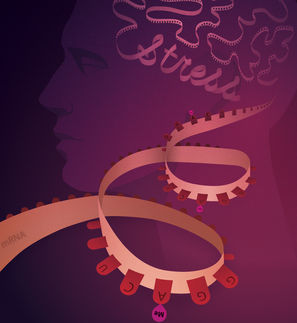Before or after birth, gene linked to mental health has different effects
Mouse study links timing of expression to various abnormalities
Advertisement
Scientists have long eyed mutations in a gene known as DISC1 as a possible contributor to schizophrenia and mood disorders, including depression and bipolar disorder. Now, new research led by Johns Hopkins researchers suggests that perturbing this gene during prenatal periods, postnatal periods or both may have different effects in mice, leading to separate types of brain alterations and behaviors with resemblance to schizophrenia or mood disorders. The findings, reported in Molecular psychiatry, could eventually help researchers treat mental illness in people or even prevent it.
To manipulate DISC1 expression during different periods, the researchers, led by Associate Professor Mikhail Pletnikov, M.D., Ph.D., crafted a novel mouse model in which a mutant form of the gene could be turned off by feeding the animals small amounts of the antibiotic doxycycline in their chow. The animals could get the drug directly by eating it or through their mothers during gestation. Withdrawing doxycycline turned this gene on. (All the animals also carried the normal DISC1 gene, which wasn't affected by the drug.)
Using this model, Pletnikov's team generated four groups of mice: those that expressed mutant DISC1 prenatally (Pre), those that expressed mutant DISC1 postnatally (Post), those that expressed it during both periods (Pre+Post), and those that never expressed it (NO).
When the mice were about 2 months old, the researchers put the animals through a battery of behavioral tests designed to measure characteristics similar to schizophrenia and depression in humans, such as abnormal social interactions and heightened aggression under stress, comparing these animals with "control" animals that didn't express the mutant gene.
Because previous studies have shown that male mice with mutant DISC1 have such altered traits, the researchers tested male mice in each of the groups by placing them in a cage with a normal male mouse and allowing them to mingle for 10 minutes. They counted various social behaviors, including sniffing, following and attacks. Pletnikov and his colleagues found that the Pre+Post and Post groups spent significantly less time in non-aggressive social interaction with their partners than the mice of the NO group. Those in the Pre+Post group also demonstrated significantly more aggressive attacks on their partners than control mice that did not express mutant DISC1.
To look for behaviors reflecting depression, the researchers gave animals of both sexes in all the groups a forced swim test and a tail suspension test. In both tests, the animals participated in unpleasant activities — being made to swim in a pool, or being lifted by their tails — and were timed for how long they struggled. Mice thought to exhibit depression-like behavior spend more time immobile than non-depressed mice.
Pletnikov's team found that only female mice of the Post group spent significantly more time immobile in the forced swim test than mice that did not express mutant DISC1. Female mice in the Pre+Post group spent significantly more time immobile in the tail suspension test than control mice. Male mice in each of the groups displayed similar behavior in these tests.
Finally, when the researchers examined the brains of the mice, they found significant differences between animals in different groups. Those in the Pre group had significantly smaller brain volume than the other mice. Mice in the Post and Pre+Post groups had significantly larger lateral ventricles and decreased content of dopamine, a pleasure-producing brain chemical, in the frontal cortex. Both female and male mice in the Pre, Post and Pre+Post groups had fewer neurons that produce GABA, a brain chemical that regulates nerve cell firing, than mice in the NO group.
The researchers say both the behavioral and physiological findings suggest that expressing mutant DISC1 at different time points during fetal or early childhood development can lead to different outcomes. While selective prenatal expression led to smaller brain volumes but mild behavioral effects, pre- and postnatal expression led to behaviors and brain alterations in male mice similar to schizophrenic humans, and postnatal expression produced abnormalities in female mice similar to depression.
The researchers aren't sure why the animals varied according to sex. However, Pletnikov notes, schizophrenia and depression also vary between the sexes in humans, with schizophrenia more prevalent in males and depression more prevalent in females. He and his team plan to study these sex-related differences in future studies.
The team also plans to try to narrow the time periods in which mutant DISC1 is turned on in their model to study particular stages, such as early postnatal development, sexual maturity, adulthood and aging, since triggers at each of these stages might bring on mental illness.
The goal, says Pletnikov, is to use these findings to develop new therapies to treat psychiatric disorders.




























































